The Best New Perennial Flowers of 2024
January 23rd, 2024
A cross between coneflowers and gloriosa daisies, a new variety of a little-known native plant, and the smallest native Joe Pye flower yet top the list of interesting new perennials debuting in the 2024 growing season.
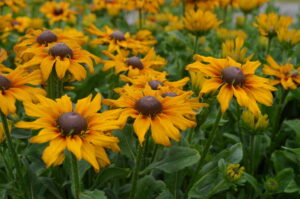
Echibeckias are a cross between coneflowers and rudbeckia.
Credit: Quality Greenhouses
Growers, local garden centers, and other plant experts picked the following 14 choices for my annual January four-part, best-new-plants series.
The article on best new edibles of 2024 appeared Jan. 9, while the rundown on best new annual flowers posted last Tuesday, Jan. 16. The series ends next Tuesday, Jan. 30, with a look at the best new trees and shrubs of 2024.
The following new perennial flowers are available online and in some plant catalogs and will start showing up in local garden centers in April.
The details:
You probably have never heard of an “echibeckia,” which is understandable since the plant is a recently developed cross between coneflowers (Echinacea) and gloriosa daisy (Rudbeckia). But if you lean toward the new and different and are willing to accept the possibility that this “perennial” may not make it through our winters, consider that the Summerina series of echibeckias was showy enough to earn the 2023 Editor’s Choice Medal of Excellence award from the Greenhouse Grower trade magazine.
The producer of this 10-color series, California-based Pacific Plug and Liner, touts the line as the “most interesting plant in the world” for the big flowers, fast growth, long bloom time, disease-resistance, and flower colors that offer “bursts of rich browns, oranges and yellows.”
The plants have the habit and central flower cones of coneflowers but the warm colors of gloriosa daisies.
The down side is that these hybrids are listed as winter-hardy only down to Zone 7, which puts them in the border-line “safe” zone for most of the Harrisburg area, which is now listed as Zone 7a in the newly revised U.S. Department of Agriculture Winter Hardiness Zone Map.
Echibeckia prefer full sun and overwinter best in a protected microclimate, such as along a heated house wall.

Stokesia Totally Stoked ‘Riptide’ is a pollinator-friendly native perennial that’s not well known.
Credit: Proven Winners
Stoke’s aster Totally Stoked ‘Riptide’
Stoke’s aster (Stokesia laevis) is another little known perennial despite being a U.S. native wildflower.
Robert Kadas, owner of Highland Gardens in Lower Allen Twp., thinks a new variety of it called ‘Riptide’ has the potential to become a hit, given the recent popularity of both native plants and ones that are pollinator-friendly.
“I’ve always loved stokesias because of how easy they are to grow for most people,” Kadas says. “’Riptide’ has abundant periwinkle-blue flowers through the summer on rich, dark-green foliage. It’ll form a nice, dense plant that grows two feet tall and three feet across.”
He adds that this is a perennial that tolerates heat and humidity well, is loved by bees and butterflies, and is hardly ever bothered by deer or rabbits.
Proven Winners is introducing ‘Riptide’ as one of the first two entries in a new series called Totally Stoked. The other newbie is a white-bloomer called ‘Whitecaps.’
Joe Pye Little-Pye
Another trouble-free native that’s a veritable pollinator magnet is Joe Pye weed (Eupatorium), but its original form grows a hefty five to six feet tall. That’s too big for a lot of home gardens.
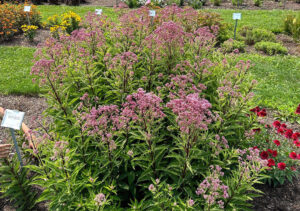
Eupatorium Little-Pye is a compact new native that performed well at Penn State’s Trial Gardens in Lancaster County.
Credit: Penn State Trial Gardens
Krystal Snyder, the interim director at Penn State’s Trial Gardens in Lancaster County, singles out Little-Pye as her favorite new perennial of 2024 for its super-compact habit – topping out at only around 14 inches tall and wide.
Penn State has been trialing Dummen Orange’s Little-Pye for three years now, and Snyder says it has bloomed nicely and performed well each year, scoring a perfect 5.0 rating last summer.
Plants flower purplish-pink (peaking in July), do well in full sun to light shade, and are hardly ever bothered by animals, including deer.
Like all Joe Pye, this one is also tolerant of wet soils.
Coneflower Double Scoop Deluxe
This new four-color line of coneflowers stands out for its compact habit (less than two feet tall) and heavy set of double-petaled flowers.
The Watermelon variety of Double Scoop Deluxe coneflowers is especially attractive and won a Retailer’s Choice award at last summer’s AmericanHort Cultivate industry show as a new plant with the potential to become a garden-center best-seller.
Introduced by Darwin Perennials, the Double Scoop series features Orangeberry, Raspberry, and Strawberry varieties in addition to Watermelon.
Coneflowers, which are U.S. natives, grow best in full sun and are seldom bothered by deer.
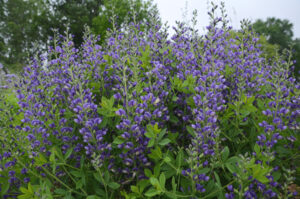
Blueberry Sundae is a native baptisia with indigo-blue flowers.
Credit: Proven Winners
False indigo Decadence ‘Blueberry Sundae’
Brandon Kuykendall, the nursery manager at Ashcombe Farm and Greenhouses in Monroe Twp., picks this bush-like native (also known as baptisia) as his favorite new perennial of 2024.
“I like that this false indigo has a compact habit with deep indigo-blue flowers,” he says. “It’s a great plant that needs little maintenance once established.”
‘Blueberry Sundae’ is a Proven Winners introduction that grows only two-and-a-half to three feet tall and wide – more compact than most types, which often run in the four- to five-foot range.
It blooms for several weeks from late spring into early summer and prefers full sun, although it’ll also do well in half-day sun.
Switchgrass ‘Red Flame’
Another native species that deer usually don’t bother is red switchgrass.
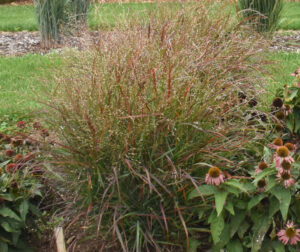
The blades of red switchgrass ‘Red Flame’ turn wine-red in the fall.
Credit: Walters Gardens
Bryan Benner, a grower at the wholesale Quality Greenhouses near Dillsburg, likes a new variety of it called ‘Red Flame’ as his favorite perennial of any sort for 2024.
Benner says the blades start out blue/green and then turn wine-red until the end of summer.
“In the fall, I like the way the stems age to a wheat color with a few red leaves to contrast,” he adds.
‘Red Flame’ plants grow about three-and-a-half feet tall, including the purplish-red flower plumes that form in late summer.
Introduced by Michigan-based Walters Gardens, ‘Red Plume’ grows best in full sun and tolerates a range of soil and moisture conditions.
Agastache ‘Pink Pearl’
This 2024 introduction from Oregon-based Terra Nova Nurseries brings a new color to hummingbird mint, an upright perennial that lives up to its name by being a magnet for hummingbirds and other pollinators.
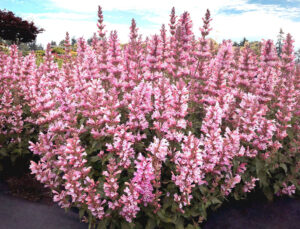
Agastache ‘Pink Pearl’ blooms pink, which is a departure from the species usual blue to blue-purple flowers.
Credit: Terra Nova Nurseries
‘Pink Pearl’ is different for its light pink blooms that are large and densely covered in addition to being a departure from agastache’s usual purple to blue-purple flowers.
“‘Pink Pearl’ delivers an extended bloom time and grows fast and easily with good drainage,” says Terra Nova President Dan Heims, who picks the variety as his favorite new perennial of 2024. “It features larger and denser blooms compared to previous cultivars, making it an eye-catcher in mid-to-front garden borders and home containers.”
He adds that it branches densely without pinching, has excellent disease resistance, tolerates drought, blooms for months from June to September, and is seldom bothered by deer.
‘Pink Pearl’ does best in full sun and grows about 16 inches tall.
Helleborus The Rockies ‘Hollowtop Mountain’
Novel leaf colors are the draw behind this new series of hellebores (Lenten rose) being introduced by Ohio-based Aris Horticulture under the Must Have Perennials brand.
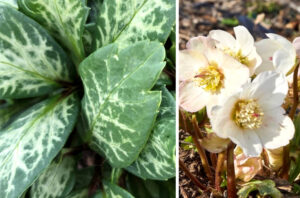
The Rockies series of helleborus is distinctive for its range of leaf colors. Above is the variegated leaves and white flowers of ‘Hollowtop Mountain.’
Credit: MustHavePernnials.com
“The Rockies is a collection bred specifically for unique and beautiful foliar interest,” says Laura Wagner, the brand’s senior product manager. “It includes varieties with creamy white variegation, bright gold leaves, silver spiky leaves, and white-flecked foliage that looks like snow.”
Wagner’s favorite of the six-plant series is ‘Hollowtop Mountain,” which has early-spring white flowers and green foliage with white veins and white marbling.
Like all of The Rockies series, ‘Hollowtop Mountain’ grows a compact eight to 10 inches tall in shade or part shade. And like all hellebores, it’s not a plant that deer and rabbits are likely to bother.
Others in The Rockies series include ‘Grand Teton’ (gray-blue spiny leaves and dark burgundy flowers), ‘Table Mountain’ (chartreuse to gold foliage and rosy-purple flowers), and ‘Mt. Nebo’ (red new foliage that morphs to speckled white and green in summer with rose-blushed white flowers).
Here’s another new deer- and rabbit-resistant plant where the foliage is the starring trait.
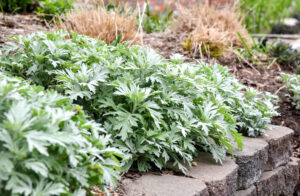
Artemisia ‘Silver Lining’ has frilly silver leaves and a compact, no-flop growth habit.
Credit: Walters Gardens
Artemisia ‘Silver Lining’ is a low, mounding plant with cut-edged silver leaves.
Walters Gardens, which is introducing the plant under the Proven Winners brand, says it’s a hybrid of a native species (Artemisia ludoviciana) that brings that plant’s leaf color and cold-hardiness but not its spreading runners (which can make the straight species overly aggressive in a perennial garden).
Walters’ Nicole Hoonhurst says ‘Silver Lining’ doesn’t flop apart as many artemisias do, and it makes a good foliage “spiller” in pots as well as a filler in a sunny landscape bed.
Plants grow about 16 inches and tolerate drought and poor soil.
Phlox Luminary ‘Prismatic Pink’
If it’s vibrant flower color you’re after, Walters Gardens and Proven Winners are also introducing this new native perennial in 2024 that has bright bubble-gum pink flowers with darker green centers.
I test-grew ‘Prismatic Pink’ last summer and found that the blooms were both big and long-lasting (several weeks from mid to late summer). Blooms nearly covered the plant.
My test plant also showed no sign of that bane of most older phlox varieties – powdery mildew disease.
‘Prismatic Pink’ grows to just under three feet tall, making it a bit more compact than most tall garden phlox.
It blooms best in full sun, and its flowers attract bees, butterflies, and hummingbirds.
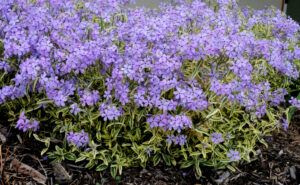
‘Blue Ribbons’ is a new native woodland phlox variety that sports variegated leaves.
Credit: Overdevest Nurseries
Phlox Blue Ribbons
Lower Paxton Twp. horticulturist David Wilson, marketing director for Overdevest Nurseries, has two favorite new perennials of 2024, and this native woodland phlox is one of them.
Wilson likes Blue Ribbons for its heavy set of pollinator-attracting lavender-blue flowers but also its color-changing variegated leaves.
“It is nice and vigorous and forms low evergreen or semi-evergreen clumps of ever-changing foliage,” he says. “In spring, plants start out with boldly margined yellow and green leaves that gradually change to creamy-white, and then with shorter days and cooler nights, the foliage takes on delightful red and even burgundy-purple shades.”
Blue Ribbons grows about three inches tall, and the clusters of fragrant early-spring flowers rise another six inches above the foliage.
Woodland phlox grows best in light or dappled shade, especially with a bit of early-morning sun and then out of direct afternoon sun.

Creeping sedum What a Doozie has heavily variegated green and white leaves.
Credit: Overdevest Nurseries
Sedum What a Doozie
Wilson’s other favorite-new perennial of 2024 is this creeping sedum with the variegated leaves and small pink flowers.
Wilson says What a Doozie is a mutation or “sport” of the popular creeping sedum ‘Tricolor,’ except this one has “crisp, clean variegation that looks to be nice and stable with no reversion observed so far.” (Reversion is when plants lose their two-tone leaf coloration and go back to plain green).
“It emerges in spring with green leaves and gold-tinted margins, then changes to creamy-white in summer, then back to golden shades again in autumn with the potential to take on additional pink hues during cool periods,” Wilson says.
What a Doozie is semi-evergreen and produces clusters of small, creamy-pink flowers in late summer that attract pollinators.
Growing only four to six inches tall, it’s ideal as a groundcover for edging beds and walkways, cascading over rocks and stone walls, or covering year-round planters.
Like most creeping sedums, What a Doozie is heat-tough, drought-tough, and best in full sun, although it’ll also do well in part shade.
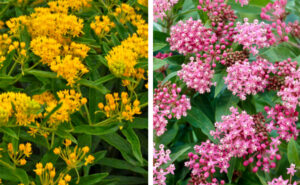
Hello Yellow, left, and Soulmate, right, are two colors that depart from the best known orange form of milkweed.
Milkweed Hello Yellow and Soulmate
The darling of butterfly perennials – especially for monarchs – is the milkweed family. The main option up to now in garden centers has been the orange-blooming butterfly weed (Asclepias tuberosa).
Given the pollinator-gardening rage lately, both catalogs and garden centers are adding new color variations this year.
One is milkweed Hello Yellow, which produces clusters of bright yellow star-shaped flowers, and the other is a selection of swamp milkweed called Soulmate, which produces cherry-pink clusters of star-shaped flowers.
Both of those flower mainly in July and August, then produce late-season “fluff” pods that send out seeds that can sprout new plants the following spring.
The mother plants are winter-hardy in the Harrisburg area and should come back year after year. Because of their tap roots, though, they don’t transplant well.
Milkweed plants grow two to three feet tall, tolerate drought and poor soil, and are a necessary species for monarch caterpillars. They grow in full sun to part shade.
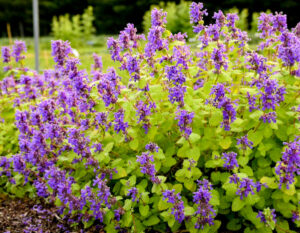
Catmint ‘Chartreuse on the Loose’ is a break-through for its chartreuse leaf color.
Credit: Watlers Gardens
Catmint ‘Chartreuse on the Loose’
Catmints are heat-tough, drought-tough perennials that typically pair greenish-gray foliage with powdery blue flowers.
The distinction with Walters Gardens’ new ‘Chartreuse on the Loose’ is that it’s a variety with bright chartreuse foliage and blue flowers.
The look was enough to earn the variety a 2024 National Garden Bureau Green Thumb Award in Professional Choice voting.
Like most catmints, ‘Chartreuse on the Loose’ is a long-bloomer, producing continuous flowers from June into fall even without the cutback that’s needed to most catmints to induce a second round of late-summer flowering.
Plants grow a mounding 10 to 12 inches tall and do best in sunny spots with well drained soil. They’re also good pollinator attractors but resistant to deer and bunny damage.
Read George’s post on best new perennial flowers of 2023







